 Get premium membership
Get premium membership and access revision papers with marking schemes, video lessons and live classes.
Form 2 Physics End of Term 3 Examination 2021
Class: Form 2
Subject: Physics
Level: High School
Exam Category: Form 2 End Term 3 Exams
Document Type: Pdf
Views: 1530
Downloads: 49
Exam Summary
TUTORKE EXAMS
NAME _______________________________________ ADM/NO.__________ CLASS______
END OF TERM THREE EXAMINATION 2022
FORM TWO
PHYSICS
TIME: 2HRS
INSTRUCTION TO CANDIDATES
a) Write your name, admission number and class in the spaces provided above
b) This paper consists of TWO Sections; Section A and Section B.
c) Answer ALL the questions in both Section A and B in the spaces provided.
d) ALL working MUST be clearly shown.
e) Candidates should check the question paper to ascertain that all the 8 pages are printed as indicted and that no questions are missing.
f) Candidates should answer the questions in English
Where necessary, take
G = 10N/kg
Density of water = 1000kg/m3
SECTION A (25 MARKS)
Answer all questions in the spaces provided
1. The figure below shows a scale which is part of Vernier calipers. What is the reading indicated by the scale? (2mks)
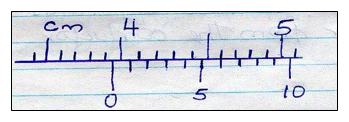
2. Two mirrored walls stand at an angle to each other. A student standing in the room counts nine images of himself in the mirrors. Determine the angle between the walls (3mks)
3. The diagram below shows the behavior of mercury in a capillary tube. Explain this observation (2mks)
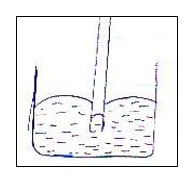
4. A body weighs 600N on the surface of the earth and 450N on the surface of another planet. Calculate the value of g in that planet (g on the earth = 10N/Kg) (3mks)
5. A steel needle when placed carefully on water can be made to float. When a detergent is added to the water it sinks. Explain this observation (2mks)
6. 200 coulombs of charge passes through a point in a circuit for 0.6 minutes. What is the magnitude of the current flowing? (3mks)
7. When marking the fixed points on a thermometer it is observed that at 00C, the mercury thread is of length 1cm and 6cm at 1000C. What temperature would correspond to a length of 4cm? (3mks)
8. The micrometer screw gauge below has a zero error of -0.19mm.
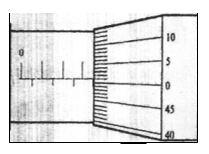
Determine the actual thickness of the object. (2mks)
9. Distinguish between hard magnetic material and a soft magnetic material (2mks)
10. In the smoke cell experiment, bright specks are observed to move in a continuous random manner. Explain this motion. (2mks)
11. State the reason why a steel sphere resting on a horizontal surface is said to be in neutral equilibrium (1mk)
SECTION B (55 MARKS)
12. (a) State Hooke’s law (1mk)
(b) In an experiment to verify Hooke’s law, a piece of rubber was fixed to a rigid support and the other end pulled with a force of ranging magnitude. The values of force and the extension were recorded as in the table below:-

(i) Plot a graph of force ( Y axis) against extension (X-axis) on the gird provided (5mks)
(i) From the graph, determine the spring constant of the rubber within elastic limit
(3mks)
(ii) What is the size of force at the elastic limit (2mks)
(c) Three identical springs A, B and C of negligible weight are connected as shown below:
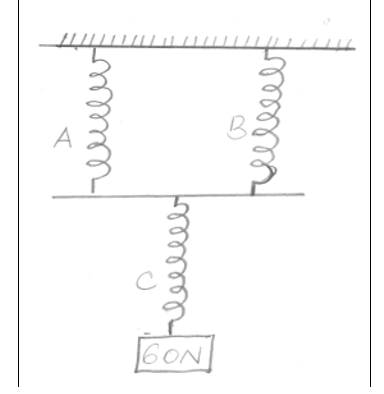
The springs support a load of 60N. If the spring constant of each is 150N/m, determine the total extension of the springs (3mks)
13. (a) State the Pascal’s principle (1mk)
(b) The height of a mercury barometer at a particular place is 70cm. given that the density of
mercury is 13600kgm3, determine;
(i) The atmospheric pressure at the place. (3mks)
(ii) The height of a water barometer at the same place. (Density of water=1g/cm3) (2mks)
(iii) Give a reason why mercury is preferred as a barometric liquid. (1mks)
(c) Calculate the minimum pressure a block of dimensions 3cm*10cm*15cm and mass 12kg
could exert on a horizontal surface. (3mks)
14. (a)In an experiment to determine the diameter of an oil molecule, an oil drop of radius 0.02cm was placed in a tray of water in which lycopodium powder had been sprinkled oil drop spread to a circular patch of radius of 0.2cm
Determine:
(i) The volume of the oil drop (2mks)
(ii) The area of the patch (2mks)
(iii) Diameter of the oil molecule (3mks)
(b) state two assumptions made in the experiment above. (2mks)
15. (a) What property of light is suggested by the formation of shadows? (1mk)
(b) A building standing 200m from a pinhole camera produces on the screen of the camera an
image 2.5cm high 5.0cm behind the pinhole.
Determine the actual height of the building (3mks)
(c) An object of height 2.0cm is placed 5.0cm in front of a convex mirror of focal length
10.0cm
(i) On the grid provided, draw to scale a ray diagram to locate the position of the
image.(4mks) (A graph paper to be provided)
(ii) Calculate the magnification produced by the mirror. (2mks)
16. (a) State the principle of moments (1mk)
(b) The figure below shows a uniform metre rule of mass 300g acted upon by a number of forces.

Determine;
(i) Sum of clockwise moments(leave your answer in terms of W) (2mks)
(ii) Sum of anticlockwise moments (2mks)
(iii) The force W (2mks)
17. The figure below shows an electromagnet
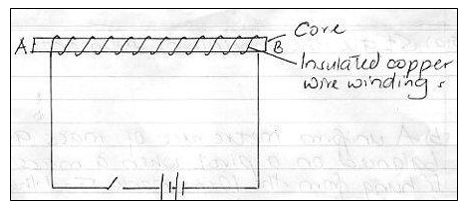
(i) Explain why the cord is made up of iron and not steel (2mks)
(ii) On the same diagram indicate the direction of the current flow when the switch is closed (1mk)
(iii) When current is allowed to flow, the electromagnet becomes magnetized.
Identify the poles of the magnet (2mks)
A. __________________________________
B. ___________________________________
(iv) State three factors that affect the strength of the electromagnet (3mks)
More Examination Papers